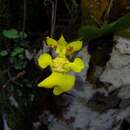en
names in breadcrumbs


Plant small, caespitose, very variable, up to 8 cm. high. Stems abbreviated, entirely concealed by a flabelliform or suborbicular cluster of leaves which are imbricated at the base. Leaves equitant, more or less oblique and falcate, linear, linear-oblong to oblong-elliptic or rarely elliptic (often slightly broader above the middle), acute or rarely obtuse, up to 7 cm. long and (rarely) 1.2 cm. wide. Scapes subequaling the leaves, axillary and often several to a plant, more or less flattened and narrowly bialate above, terminating in an abbreviated 1- to 6-flowered raceme. Floral bracts short, conduplicate-triangular, dorsally carinate, shorter than the pedicellate ovary which is 6- winged and 8 mm. or less long. Flower variable, large for the plant, membranaceous, with wide-spreading segments, yellow often with orange, red-brown or purplish spots. Dorsal sepal relatively small, elliptic to obovate or suborbicular, acute, apiculate to broadly rounded at the tip, dorsally carinate, 5-6 mm. long, 2.2-4.5 mm. wide. Lateral sepals obliquely lanceolate, acute or acuminate, apiculate, concave, dorsally carinate, a little shorter (longer according to Cogniaux) and much narrower than the dorsal sepal. Petals much longer and broader than the dorsal sepal, elliptic-oblong to obliquely round- obovate, acute, apiculate or rounded at the apex, undulate. Lip much larger than the other segments, pandurate-trilobed, sessile with an auriculate base, retuse to bilobed at the apex, about 13.2-18.5 mm. long from the base to the tip of an apical lobe, about 12-18 mm. wide across the lateral lobes near the base and 10.8-22 mm. wide across the mid-lobe; lateral lobes relatively small, spreading, suborbicular or obovate-suborbicular; mid-lobe much larger, from a short broad claw semiorbicular, more or less indented in the middle of each side (and thus 4-lobed) ; disc at the base with a prominent, 3-lobed callus of which the lateral lobes are broad, lobulate and flat and the mid-lobe longer and convex. Column very short and stout, about 1.5-2 mm. or more high at the back, semi-orbicular-dilated on each side below, with a pair of prominent, semiorbicular- flabellate, crenulate or deeply dentate wings above.
Erycina pusilla is an epiphytic orchid native to Central America and Northern South America (Schweinfurth 1961).
Erycina pussilais fast-growing and has a relatively low chromosome number (n = 6; Felix & Guerra 1999) and small genome size (1.5 pg per 1C nucleus; Chase et al. 2005). Pollination and production of seed capsules rarely occurs in nature (Damon & Salas-Roblero 2007). Advances in cultural techniques and precocious flowering have meant that E. pusilla can be grown rapidly, and will produce flowers and fruit in vitro (Chen et al. 2000, Chiu et al. 2011). These characteristics make E. pusilla not only an attractive model plant for functional genomic and flowering studies ofOncidium, a related genus of great economic significance, but also an excellent parent for traditional hybridization methods. To produce attractive traits and breed new commercial orchid species, E. pusilla has been crossed with several important Oncidiinae orchids, and different hybridization compatibility was found with Oncidium, Rodriguezia and Tolumnia(Lin et al. 2011).